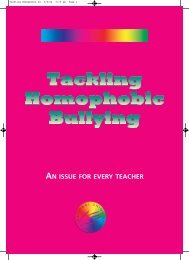Non-Normative Gender and Sexual Identities in Schools: - Schools Out
Non-Normative Gender and Sexual Identities in Schools: - Schools Out
Non-Normative Gender and Sexual Identities in Schools: - Schools Out
You also want an ePaper? Increase the reach of your titles
YUMPU automatically turns print PDFs into web optimized ePapers that Google loves.
Lesbian <strong>and</strong> Gay A4 4/1/04 3:53 PM Page 2<br />
Introduction<br />
This guidance provides <strong>in</strong>formation <strong>and</strong> advice to<br />
NUT members on support<strong>in</strong>g pupils who are lesbian,<br />
gay, bisexual or transgender (LGBT) <strong>and</strong> on tackl<strong>in</strong>g<br />
homophobia with<strong>in</strong> the school environment.<br />
<strong>Schools</strong> should be a place where diversity does not<br />
mean discrim<strong>in</strong>ation <strong>and</strong> where the dignity of all<br />
<strong>in</strong>dividuals is respected.<br />
Teachers have a key role, therefore, <strong>in</strong> tackl<strong>in</strong>g<br />
homophobia <strong>in</strong> schools <strong>and</strong> creat<strong>in</strong>g a positive<br />
school environment for all students. Headteachers<br />
<strong>and</strong> school govern<strong>in</strong>g bodies have a responsibility<br />
to ensure that all young people receive a full <strong>and</strong><br />
balanced education <strong>and</strong> are provided with a safe<br />
<strong>and</strong> secure school environment <strong>in</strong> which to learn.<br />
The lesbian, gay, bisexual <strong>and</strong> transgender<br />
community is a diverse community. It is made up of<br />
people from different religions, ethnic groups,<br />
disabled people <strong>and</strong> people of different ages.<br />
Substantial change <strong>in</strong> the underst<strong>and</strong><strong>in</strong>g of <strong>and</strong><br />
social attitudes towards sexual orientation over the<br />
last few decades has led to considerable<br />
improvements <strong>in</strong> the position of LGBT people<br />
with<strong>in</strong> society.<br />
Many LGBT students, however, are still bullied or<br />
feel alienated because of homophobia. Research<br />
has shown that homophobic bully<strong>in</strong>g can lead to<br />
educational underachievement, lack of confidence<br />
<strong>and</strong> even suicide.<br />
This guidance provides helpful advice <strong>and</strong> support<br />
for teachers <strong>in</strong> their work to help all young people<br />
become confident learners <strong>and</strong> prepared for life<br />
after school.<br />
A Whole School Approach<br />
Support<strong>in</strong>g LGBT pupils <strong>in</strong>volves ensur<strong>in</strong>g that<br />
LGBT issues are <strong>in</strong>cluded <strong>in</strong> all areas of the work of<br />
the school from school policies <strong>and</strong> procedures, to<br />
the curriculum <strong>and</strong> to the tra<strong>in</strong><strong>in</strong>g opportunities<br />
the school offers to its employees.<br />
All schools should have an equal opportunities<br />
policy that <strong>in</strong>cludes a section on equality for LGBT<br />
students, staff, <strong>and</strong> parents. Equal opportunities<br />
policies are valuable. They clarify the approach of<br />
the school for staff, pupils, governors,<br />
parents/carers <strong>and</strong> external agencies <strong>and</strong> enable<br />
staff to manage equal opportunities issues with<br />
confidence, competence <strong>and</strong> consistency.<br />
In order for a whole school equal opportunities<br />
policy to be effective, all members of the school<br />
community, <strong>in</strong>clud<strong>in</strong>g pupils, staff, parents <strong>and</strong><br />
governors, should be <strong>in</strong>volved <strong>in</strong> its development.<br />
It should cover all aspects of school life, <strong>in</strong>clud<strong>in</strong>g<br />
the curriculum, organisation, staff<strong>in</strong>g <strong>and</strong><br />
management with the aim of enrich<strong>in</strong>g the culture<br />
<strong>and</strong> ethos of the school.<br />
Develop<strong>in</strong>g an equal opportunities policy is the<br />
start of the process of promot<strong>in</strong>g equality <strong>and</strong><br />
tackl<strong>in</strong>g discrim<strong>in</strong>ation <strong>and</strong> schools should<br />
regularly review the policy <strong>and</strong> monitor its<br />
effectiveness <strong>in</strong> meet<strong>in</strong>g its aims.<br />
New legal responsibilities are now <strong>in</strong> place which<br />
require LEAs <strong>and</strong> govern<strong>in</strong>g bodies, as employers,<br />
to protect all employees from discrim<strong>in</strong>ation,<br />
harassment or victimisation on the grounds of their<br />
actual or presumed sexual orientation. This<br />
provides a legal impetus for schools to challenge<br />
homophobia. The Regulations 1 ban discrim<strong>in</strong>ation<br />
on the grounds of sexual orientation <strong>in</strong><br />
employment <strong>and</strong> <strong>in</strong> vocational tra<strong>in</strong><strong>in</strong>g. <strong>Schools</strong><br />
that fail to challenge homophobic abuse of staff<br />
whether from other staff, pupils, parents/carers or<br />
other members of the school community, could be<br />
liable to challenge <strong>and</strong> could be required to pay<br />
compensation.<br />
Awareness Through the Curriculum<br />
<strong>Schools</strong> can consider us<strong>in</strong>g the curriculum <strong>in</strong> the<br />
follow<strong>in</strong>g ways:<br />
●<br />
●<br />
●<br />
The school should be clear about the purpose<br />
of adopt<strong>in</strong>g a broad curriculum approach. Such<br />
an approach can raise awareness of bully<strong>in</strong>g<br />
issues amongst pupils. Equally it can challenge<br />
<strong>and</strong> deconstruct the homophobic attitudes that<br />
might lead children to bully.<br />
A review can be conducted of the exist<strong>in</strong>g<br />
subject curriculum that might support antihomophobic<br />
messages <strong>and</strong> foster respect for<br />
the dignity of <strong>in</strong>dividuals.<br />
Tra<strong>in</strong><strong>in</strong>g on homophobic bully<strong>in</strong>g can be<br />
<strong>in</strong>cluded. The resource list at the back of this<br />
guidance will help.<br />
It is far better that children are provided with<br />
accurate <strong>in</strong>formation <strong>in</strong> the classroom rather than<br />
<strong>in</strong>accurate <strong>in</strong>formation <strong>in</strong> the playground. Whilst<br />
PSHE <strong>and</strong> Citizenship is the most obvious location<br />
<strong>in</strong> the curriculum, there are l<strong>in</strong>ks to be made with<br />
other subjects. Issues surround<strong>in</strong>g relationships,<br />
stereotypes <strong>and</strong> prejudice can be explored with<strong>in</strong><br />
Art, English, Drama, History or RE.<br />
It is important for primary schools to provide<br />
positive images of lesbian, gay <strong>and</strong> bisexual people<br />
<strong>and</strong> for the sexual orientation of famous <strong>and</strong><br />
successful lesbian, gay <strong>and</strong> bisexual people both<br />
past <strong>and</strong> present to be acknowledged <strong>in</strong> every<br />
subject. This work needs to be placed <strong>in</strong> a wider<br />
context where lesbians, gay men <strong>and</strong> bisexual<br />
people are seen as citizens <strong>and</strong> participants <strong>in</strong> a<br />
wide range of activities.<br />
1







